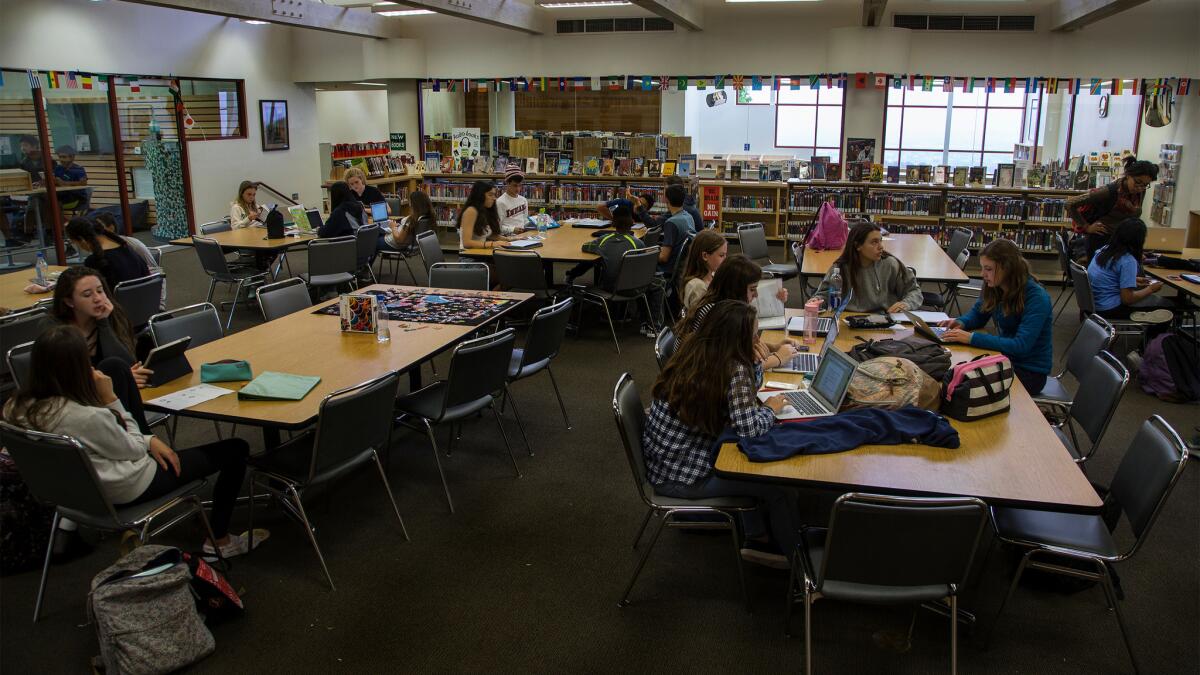Activists reveal more dark-money donors to campaigns against unions and schools-funding tax

- Share via
About $7 billion a year in school funding will be at stake this fall when voters decide whether to extend Proposition 30, a tax on high-income Californians.
Those in favor of the tax went on the offensive Tuesday, shining a spotlight on people who gave undisclosed money to fight the levy.
A coalition of unions and self-described progressive organizations released the names as part of an effort to extend the temporary tax, which passed in 2012 and is set to expire in 2018.
The group, called California Hedge Clippers, said the donors they named had made undisclosed contributions in 2012 as part of an unsuccessful “dark-money” scheme to defeat the tax.
Some big-name donors, including billionaire philanthropist Eli Broad, were exposed earlier, after voters approved the tax and the publicity-dodging maneuver was revealed. On Tuesday, the new group named 76 more.
The activists’ game plan could be called preventive disclosure, or strategic shaming.
“Dozens and dozens of California’s wealthiest individuals secretly worked to try to make sure this measure would never pass,” said Amy Schur, state campaign director for the L.A.-based Alliance of Californians for Community Empowerment, which is part of the coalition.
“Proposition 30 is too crucial to risk their interference this time around. We’re calling them out,” added Schur, whose group is part of Hedge Clippers.
Individuals named in the group’s report include Silicon Valley tech and investment executive John H. Scully ($500,000), investor and Hyatt Hotel heir Anthony Pritzker ($100,000), developer Geoff Palmer ($100,000) and private equity investor Gerald Parsky ($50,000).
Donors, regulators concluded, contributed money to an out-of-state organization, which circulated funds through a series of other groups and eventually back to California. By then, the identity of the donors was beyond the reach of disclosure laws.
As the money was channeled to California, some transfers were not properly disclosed and therefore violated the law, officials said. Well after the election, a California investigation resulted in $16 million in fines to some of the groups as well as the disclosure of some donors, including Broad, who either gave $500,000 or $1 million, depending on how the source documents are interpreted. The donors were not fined.
The new names emerged this week from sleuthing based on a partially redacted list of donors that a political operative had provided to regulators. On it, names and addresses of so-called “dark money” donors are partially blacked out. But enough remained in view to allow the cross-referencing of visible information with more complete public filings elsewhere, researchers said.
California Hedge Clippers is a regional wing of a national coalition. Its reports target the “one percent,” wealthy Americans who hold opposing political views.
Among the names to emerge in the California research is Nils Colin Lind ($50,000), who was at the time an executive at Blum Capital, the firm he co-founded with Richard Blum, California Sen. Dianne Feinstein’s husband. The larger contributions include $800,000 from machine-tool manufacturer Gene Haas. The researchers also uncovered additional money from the Fisher family, heirs to the Gap fortune and among the most generous supporters of charter schools; their revised total is $10 million.
The list also includes leaders of the charter school movement, such as Scully and Tony Ressler ($25,000), a former longtime board member of the charter group Alliance College-Ready Public Schools.
Like other public schools, charters reaped huge financial benefits from Proposition 30 after it passed in 2012. School officials across the state hope voters in the November election will extend the tax on the wealthiest 2% of earners.
Critics say that the measure is unfair or unnecessary, especially because increased tax revenue from an improving economy has brought more money to education.
Using the same methods as the researchers, The Times was able to verify many of the names on the partially redacted list, including Pritzker, Lind and Scully. Efforts to reach them were not successful.
But Ressler, one of the donors verified through this method, did call back and said that he doesn’t remember the $25,000 contribution or the groups through which regulators said the donations were funneled. Ressler, on Forbes’ list of billionaires with an estimated worth of $1.19 billion, has long been active in supporting charter schools and other education reform efforts.
Ressler said that the cause of improving education is extremely important to him.
“Anything that helps public education I am in favor of,” he said. “My hope is that public education will improve dramatically.”
In 2012 stopping Proposition 30 was one of two presumed goals for the hidden donations. The money also went to pass Proposition 32, which would have limited the ability of unions to collect political funds from members. It’s impossible to determine which of the two campaigns donors wanted to influence or whether they were interested in both.
Whatever the case, the efforts failed.
The donors’ money traveled a circuitous path. They contributed to Americans for Job Security, a Virginia trade association. This outfit then passed the money to the Center to Protect Patient Rights in Arizona. The center next sent $11 million to a Phoenix group, Americans for Responsible Leadership, which provided it to the Small Business Action Committee. That committee spent the money on the California campaigns.
In another relay, the Center to Protect Patient Rights provided more than $4 million to the America Future Fund in Iowa, which passed the money to the California Future Fund for Free Markets, a campaign committee supporting Proposition 32.
Not all of the donated money made it back to California. About $10 million was captured by groups in other parts of the country, the researchers said.
Editor’s note: Education Matters receives funding from a number of foundations, including one or more associated with people mentioned in this article. The California Community Foundation and United Way of Greater Los Angeles administer grants from the Baxter Family Foundation, the Broad Foundation, the California Endowment and the Wasserman Foundation. Under terms of the grants, The Times retains complete control over editorial content.
[email protected] | Twitter: @howardblume
[email protected] | Twitter: @maloym
[email protected] | Twitter: @LATDoug
ALSO
California has a lot more water than some think, new Stanford study suggests
Parents of Navy SEAL file wrongful-death claim against parachute maker
Violence in Sacramento shows old and new faces of white extremism
UPDATES:
4:50 p.m.: This article was updated with additional details and comments.
This article was originally published at 12 a.m.
More to Read
Sign up for Essential California
The most important California stories and recommendations in your inbox every morning.
You may occasionally receive promotional content from the Los Angeles Times.













